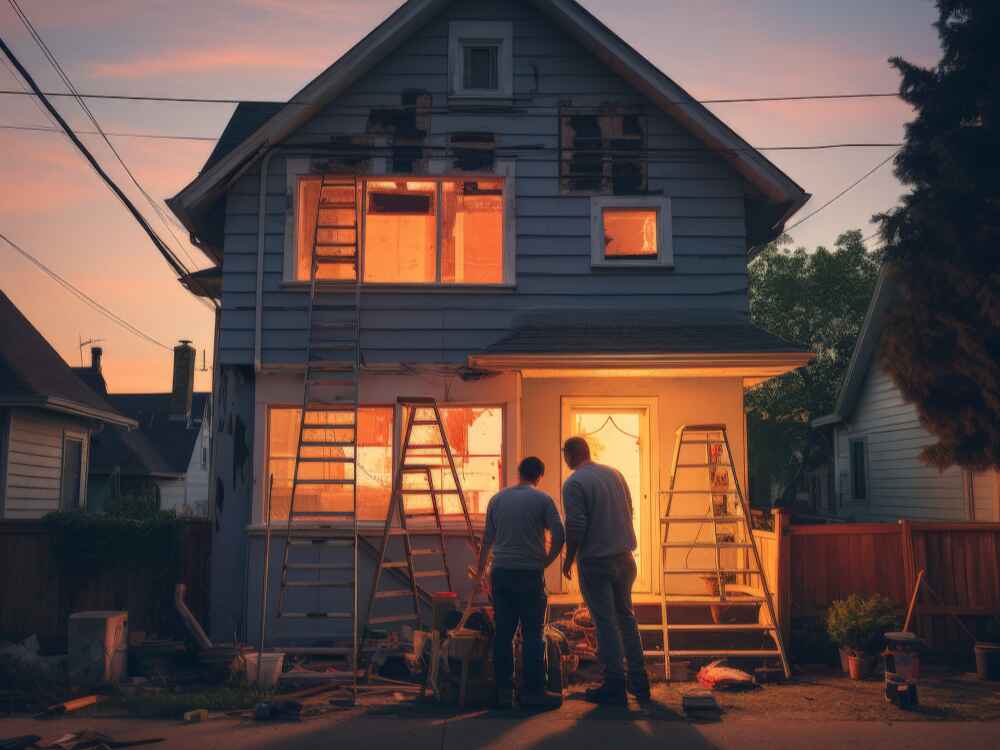Geen zin in de intro? Ja kan direct door naar de rekentool.
Je huis verbouwen is een van de meest opwindende en een van de meest slopende (in meer opzicht dan een) projecten die je ooit zult ondernemen. Droom je van een strakke nieuwe keuken, een spa-achtige badkamer of een complete make-over van je huis? Dan is er één cruciaal element dat jouw droom werkelijkheid maakt: een realistisch budget. Daar komt slimme planning samen met praktische tools, en precies daarom hebben we een uitgebreide renovatiekostencalculator ontwikkeld.
Waarom de meeste renovatieprojecten het budget overschrijden (en hoe je dit kunt voorkomen)
Statistieken tonen aan dat bijna 70% van de renovatieprojecten hun oorspronkelijke budget met 20% of meer overschrijden. De redenen zijn verrassend gewoon: onverwachte structurele problemen, onderschatting van materiaalkosten, vergeten installatiekosten, het gevreesde “”nu we toch bezig zijn”” syndroom dat leidt tot uitbreiding van het project en natuurlijk niet te vergeten: een onvolledig plan aan het begin. (Bij een deur horen ook scharnieren en die zijn niet gratis).
Nederland brengt unieke uitdagingen met zich mee bij verbouwingen. Ons woningbestand komt vaak met verrassingen die verborgen zitten achter decennia oude muren en plafonds. Bouwvoorschriften zijn streng; materiaalkosten zijn hoog. Arbeidskosten lopen snel op – je schilder moet ook ergens wonen en misschien geld naar Polen sturen – en dan moet hij ook nog BTW rekenen. Dit laatste punt is belangrijk, omdat bouwvakkers de neiging hebben om exclusief BTW te denken wanneer ze prijzen noemen.
Maar hier is het goede nieuws: met goede planning en de juiste tools kun je vanaf dag één de controle over je renovatiebudget nemen.
Zelf doen of een professional inhuren: wie moet je renovatie beheren?
Een van de belangrijkste beslissingen die je zult nemen is of je alle planning zelf wilt afhandelen of een aannemer inhuurt. Zelf beheren kan geld besparen op coördinatiekosten, maar is niet makkelijk, vooral wanneer je vergunningen, onderaannemers, leveringen en planning moet combineren met een baan. Het inhuren van een professional maakt je verbouwen snel 15% duurder, maar bespaart jou tijd, vermindert kostbare fouten, en vergroot de kans dat het project op schema blijft. Hoe complexer het project (denk aan structurele veranderingen, meerdere vakgebieden, of een strakke planning), hoe meer waarde een ervaren aannemer kan brengen. Voor kleinere of cosmetische upgrades kan de doe-het-zelf route de besparingen waard zijn, als je de tijd en organisatorische vaardigheden hebt.
Wanneer je een aannemer inhuurt, zal hij – 98% van de gevallen hij – waarschijnlijk een offerte geven voor al het werk en de materialen die je niet ziet. Elektrische bedrading, leidingwerk, beton, staal, isolatiematerialen etc. Je zult zelf alle spullen moeten kopen die de buren jaloers gaan maken: kranen, toiletpotten, vloeren, spots, deuren – de lijst gaat door tot aan deurklinken, en als je de mooie messing exemplaren wilt, komen die niet goedkoop.
Je renovatie opsplitsen: kamer-voor-kamer strategie
Keukenrenovaties: het zwaartepunt van je investering
Keukenrenovaties bieden doorgaans het beste rendement op investering, vooral als de keuken het middelpunt van je huis is. Een volledige keukenrenovatie kan variëren van €7.000 voor een basisupdate tot €50.000+ voor een premium, middelgrote keuken.
Vergeet de verborgen kosten niet: elektrische upgrades voor moderne apparaten (die inductiekookplaat gebruikt veel stroom), leidingwerk aanpassingen, en mogelijk structureel werk als je muren weghaalt.
Wie doet wat? Je aannemer zal de loodgieter aansturen voor het verplaatsen van waterleidingen indien nodig, alsmede de elektricien. (Kosten afhankelijk van wat er nog meer gebeurt) De keukenleverancier zal de installatie in rekening brengen en dat deel afhandelen. (Denk aan €1k tot €3k afhankelijk van grootte en complexiteit.)
De Badkamer: kleine ruimte, grote impact op je budget
Badkamers zijn misschien kleiner, maar zijn per vierkante meter met afstand de duurste kamers om te renoveren. Het verplaatsen of plaatsen van een bad, daarvoor zal je diep in de buidel moeten tasten.
NIeuwe leidingen, ventilatie – vergeet dit niet – en de precisie die vereist is voor tegelwerk drijven de kosten verder op. Een typische badkamerrenovatie varieert van €10.000 tot €30.000, afhankelijk van grootte en afwerking.
Wie doet het? Als je alleen je badkamer en een paar toiletten renoveert, kan je badkamerleverancier over het algemeen alles leveren en al het werk verzorgen. Als je een grote renovatie doet, kan het zinvol zijn om je aannemer het te laten afhandelen en bij discountwinkels te shoppen voor sommige items om je budget te laten kloppen. (Tegels kunnen je €100 per m² kosten maar je kunt ook voor €30 of minder gaan, waarmee je gemakkelijk €1.500 bespaart in een 6m² badkamer)
Woonruimtes: waar comfort stijl ontmoet
Kamerrenovaties bieden uitstekende flexibiliteit in budgetbeheer. Je kunt uitstekende resultaten bereiken met strategische updates: nieuw laminaat, frisse verf en bijgewerkte verlichting.
Waar zitten de kosten? Vloeren. Als je in een ouder huis woont, wil je misschien meer uitgeven aan de ondervloer dan aan de vloeren die je voeten raken op de eerste en tweede verdieping van je huis. Tenzij je vastbesloten bent om hout te hebben, zul je het verschil niet merken tussen laminaat van €13,99/m² versus €49,99/m². Maar je zal zeker spijt hebben dat je bespaarde op die ondervloer wanneer je je kinderen beneden tv hoort kijken terwijl je wilt slapen.
Behang en verf. Behang is duurder en ook moeilijker aan te brengen. Als je per sé behang wilt en het niet zelf kunt doen, vraag de winkel om opties te bieden voor behangers. Vaak kennen of hebben ze een “mannetje” die het voor een goede prijs heel netjes kan. En dit is beter dan Werkspot, want door iemand aan te bevelen zet de winkel ook hun reputatie op het spel. Wat betreft verf, er is niets mis met verliefd zijn op “Farrow and Ball”, maar wist je dat Karwei en Verfwinkel goedkopere verf in hun kleuren kunnen mengen? En zelf vergen gaat je behoorlijk wat geld besparen, als je uiteindelijk tekort komt.
Voor je begint aan je renovatie: dit moet je weten
Vergunningen en regelgeving
Elke gemeente heeft eigen regels die renovatiekosten beïnvloeden. Grote structurele veranderingen, elektrisch werk, en leidingwerk aanpassingen vereisen vaak vergunningen. Reken op €500-€2.000 voor vergunningskosten – meer als je een architect nodig hebt of alles wil uitbesteden. Mocht er kans op asbest zijn dan heb je een apart bedrijf nodig voor onderzoek en een ander bedrijf om het weg te laten halen.
Duurzaamheidsleningen en subsidies
De overheid biedt verschillende subsidies voor energiezuinige renovaties. Van isolatie-upgrades tot warmtepomp installaties, deze subsidies kunnen 20-40% van de kosten opvangen voor je warmtepomp, vloer/dak/spouwmuurisolatie en nieuwe ramen. Daarnaast hebben gemeentes vaak nog extra mogelijkheden voor leningen bovenop je hypotheek voor verduurzaming. Check wat jouw gemeente biedt.
Regionale kostenverschillen
Renovatiekosten variëren aanzienlijk door Nederland. Amsterdam en Utrecht zien doorgaans 15-25% hogere kosten dan kleinere steden, terwijl landelijke gebieden 10-15% goedkoper zijn.

“”Misschien is thuis geen plaats maar simpelweg een onherroepelijke conditie.””
– James Baldwin
Slimme budgetstrategieën die daadwerkelijk werken
De 20% regel
Professionele aannemers raden aan om 20% toe te voegen aan je oorspronkelijke budget voor onvoorziene omstandigheden. Dit is geen pessimisme—het is realisme. Oudere Nederlandse huizen kunnen vol met verrassingen zitten: verouderde bedrading, loden leidingen, rotte balken of asbest. We hebben het allemaal. Bespreek met je aannemer wat hij denkt dat je maximale risico is en probeer het risico te verdelen.
Gefaseerde aanpak
Bij een grote renovatie is je risico hoger aan het begin.
Als je budget strak is, keur in eerste instantie alleen het werk goed waarvoor je zeker je aannemer nodig hebt, maar wacht met dingen als schilderwerk en andere zaken die niet essentieel zijn of die je zelf zou kunnen doen (ook al vind je het niet leuk).
Zorg er ook voor dat je begrijpt wanneer de aannemer zijn materialen nodig heeft. Sommige bijzondere tegels hebben een lange levertijd, maar als je morgen tegels nodig hebt is er genoeg op de markt. Bestel niet vandaag alvast die tegels van €80 per m² als je niet 100% zeker bent dat ze passen binnen je budget. Zoek een goedkope optie naast je perfecte optie. Te laat voor je perfecte tegels terwijl ze wel in je budget pastte? Je hebt vast nog wel wat anders waar je het aan uit kan geven.
Zelfs een keuken kan vaak worden uitgesteld. Bezoek enkele leveranciers en controleer hun levertijden. Een grote renovatie duurt 4 tot 6 maanden en je wilt er zeker van zijn dat de keuken het laatste is wat je erin zet, anders moet je je marmeren keukenblad beschermen tegen de jongens die het plafond komen schilderen., en daar wordt je niet blij van.
Zodra je voorbij de structurele fase bent en je weet dat je niet al je buffer nodig hebt om het asbest in de badkamertegels te verwijderen (Yeah!), kun je het terugbrengen naar 8% tot 10% en het uitgeven aan de jacuzzi.
Kwaliteit versus budget balans
Investeer in kwaliteit waar het het meest uitmaakt: isolatie, je keuken, leidingwerk en elektriciteit. Dit is duur duur om later te repareren. Bespaar op gemakkelijk vervangbare items zoals verfkleuren, hardware, en decoratieve elementen.
Technologie gebruiken om op koers te blijven
Maak een budget. We adviseren om met Excel te gebruiken in plaats van alles op te schrijven in een boekje, aangezien Excel flexibiler is met het vergelijken – toevoegen en verwijderen – van verschillende opties om zo je budget passend te maken. (Om de look passend te maken is Pinterest de way to go, overigens).Misschien heb je niet veel ervaring met Excel, laat staan met verbouwingen – daarom hebben wij het zware werk alvast gedaan. We hebben een handige verbouwcalculator gemaakt die je precies laat zien waar je aan moet denken bij het opstellen van je budget. Je vult wat getallen in, downloadt ‘m als Excelbestand, en past hem helemaal aan naar jouw wensen. (Geen e-mailadres nodig of wat dan ook, maar een bedankje of een share op je favoriete social media wordt altijd gewaardeerd door Nero 😉)
De calculator houdt rekening met het feit dat je misschien meer dan 1 plee in je huis hebt en verschillende soorten kamers. Daarnaast kan je er materiaal- als arbeidskosten inzetten, om een gedetailleerde spreadhseet te maken voor je administratie en aannemersgesprekken.
Renovatiekosten Calculator
Selecteer categorieën om renovatie-items toe te voegen (klik op + of - om aantallen aan te passen)
Totale renovatiekosten
Werken met aannemers: budget-slimme benaderingen
Meerdere offertes strategie
Vraag altijd minstens drie gedetailleerde offertes aan. Kijk verder dan de eindprijs—vergelijk materiaalspecificaties, arbeidsuren, en projecttijdlijnen. De goedkoopste offerte kan snel de duurste worden wanneer er wordt beknibbeld of een deel van het werk dat je wilt ontbreekt.
Aanvullende facturering
Maak duidelijke afspraken over aanvullend werk. Als hij ervoor rekent, mag een aannemer geen aanvullend werk doen tenzij je het expliciet hebt goedgekeurd. En voordat je het goedkeurt, zorg ervoor dat je de exacte aanvullende kosten begrijpt (als je jezelf betrapt op het bespreken ervan in een half afgebouwd huis om 7 uur ’s ochtends, vraag dan naar BTW) en werk je budget dienovereenkomstig bij.
Hoeveel moet je vooraf betalen?
Je aannemer heeft vooraf geld nodig om materialen te bestellen. Betaal echter nooit meer dan 10% vooraf aan je aannemer. Na die eerste 10%, betaal je de aannemer op basis van mijlpalen (vloer klaar, stucwerk gedaan etc.) De laatste mijlpaal moet gebaseerd zijn op het feit dat a lle afwerkingsdetails klaar zijn: de laatste verflaag is droog, de deurhardware is geïnstalleerd, en zelfs die vergeten plinten zijn netjes gekit. Je renovatie is officieel voltooid.
Deadlines
Onderhandel indien mogelijk over een duidelijke deadline met je aannemer — en neem een boeteclausule op voor vertragingen (bijv. €30 tot €50 per dag na de afgesproken datum). Zonder dit loop je het risico van inconsistente voortgang: je huis kan de ene dag bruisen en de volgende dag compleet stil zijn, omdat je aannemer prioriteit geeft aan andere snelle klussen wetende dat je betaling hoe dan ook veilig is.
Je volgende stappen: van planning naar actie
Slim renovatiebudgetteren begint met realistische kostenschatting. Gebruik onze uitgebreide calculator om:
- Categorie-specifieke kosten te schatten voor je exacte projectomvang
- Verschillende scenario’s te vergelijken om je budgetallocatie te optimaliseren
- Professionele rapporten te genereren om te delen met aannemers en betere offertes te krijgen
- Voortgang te volgen en financiële controle te behouden gedurende je project
Onthoud, het beste renovatiebudget is er een dat je volledig begrijpt en waar je comfortabel aan kunt houden. Neem de tijd om onderzoek te doen, grondig te plannen, en bouw altijd die cruciale noodbuffer in.
Je droomhuisrenovatie is binnen handbereik—met de juiste planning, realistische budgettering, en slimme tools om je beslissingen te begeleiden. Begin met nauwkeurige kostenschattingen, en je zult versteld staan van hoe soepel je project kan verlopen van concept tot voltooiing.
Klaar om je renovatiebudget te gaan plannen? Probeer onze uitgebreide kostencalculator hierboven en zet de eerste stap naar je droomhuis transformatie.





